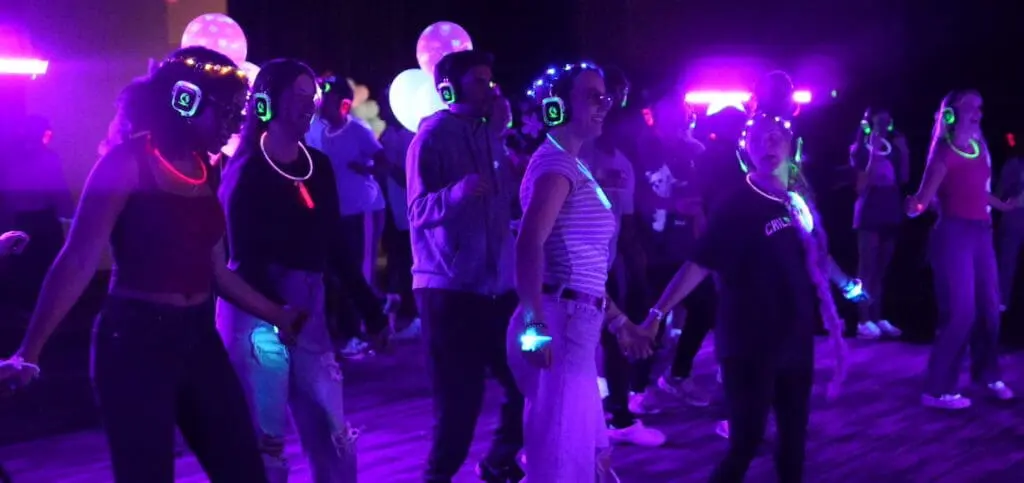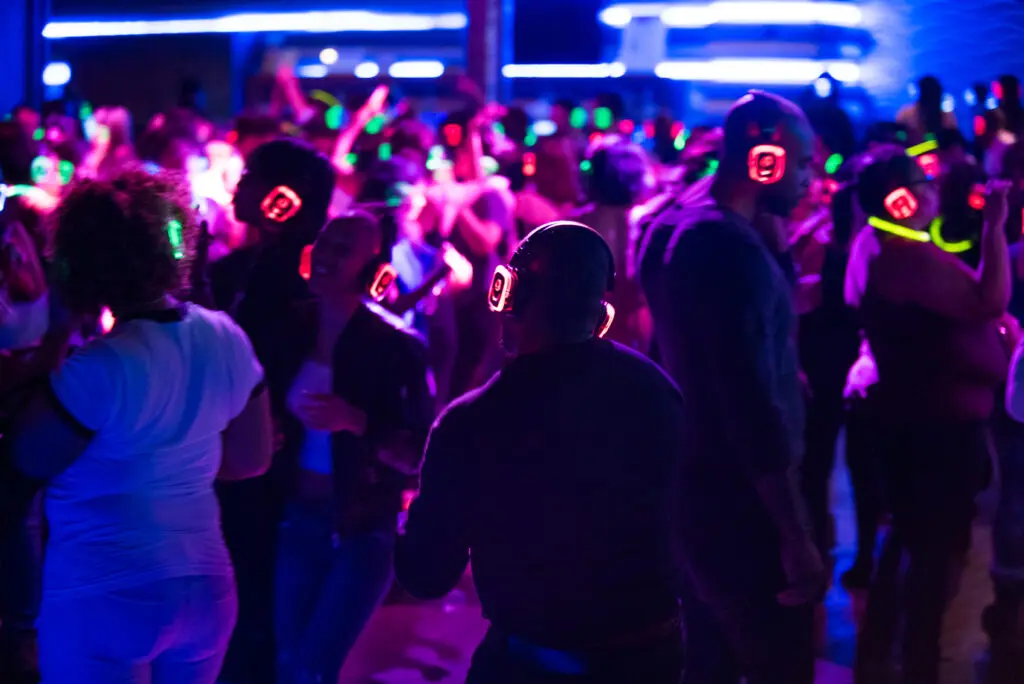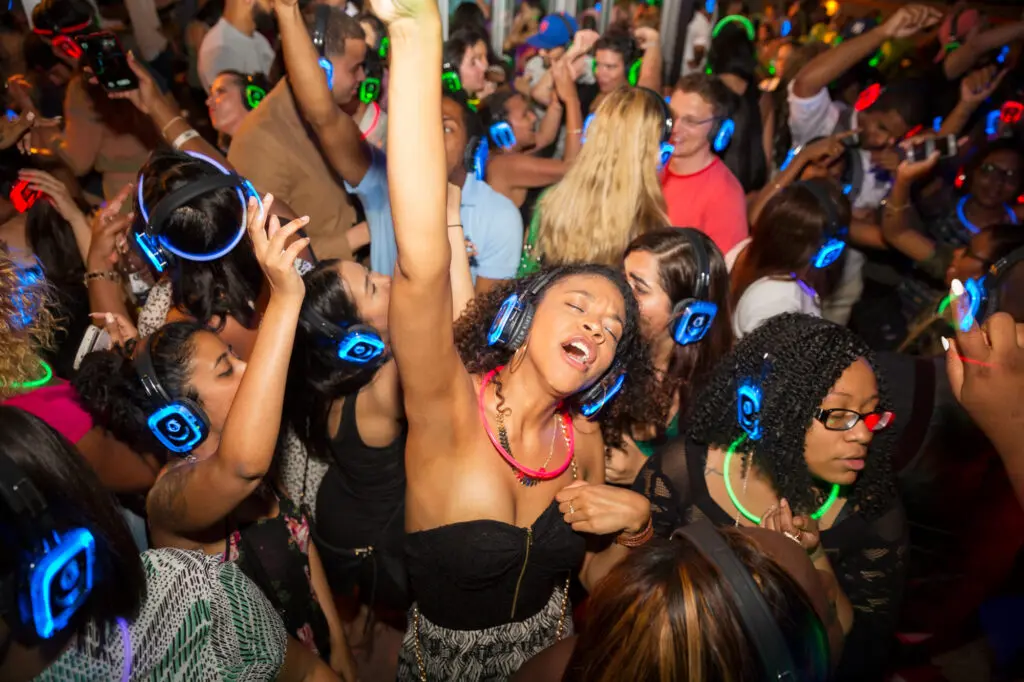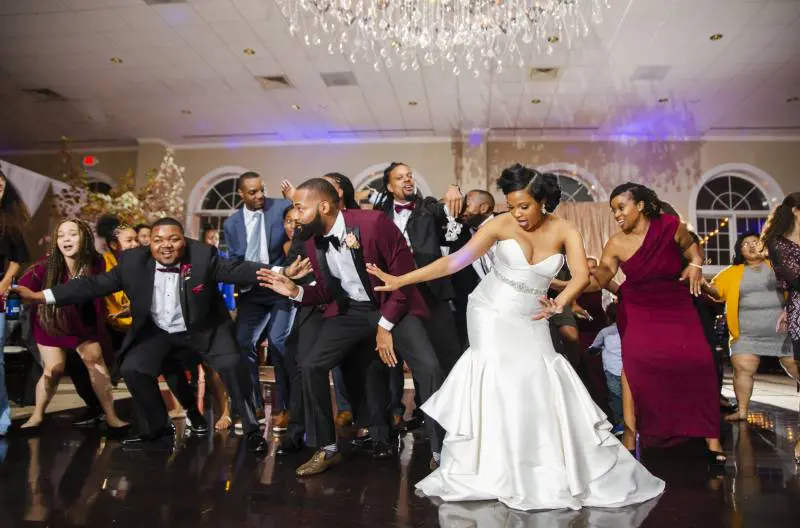The Quiet Takeover
Picture this: A packed dance floor, people are singing their hearts out and moving with a kind of pure, uninhibited joy. The air is electric, the energy is palpable, yet the room is… quiet. All you can hear is the gentle shuffle of feet and a chorus of off-key, ghostly whispers. This isn’t a scene from a strange sci-fi movie; it’s a silent disco, and it’s a lot more than just a party. It’s a full-blown cultural movement that’s quietly taking over the world, one wireless headphone at a time.

What started as a quirky solution to a logistical problem has become a powerful, transformative force in the event industry. It solves nagging issues like noise complaints, caters to a universe of different music tastes, and somehow forges a sense of shared community that’s both deeply personal and profoundly connected. This article pulls back the curtain on this quiet revolution.
What a Silent Disco Actually Is (and how it doesn’t feel like wearing a hearing aid)
At a silent disco, the music isn’t blasted through speakers. DJs, playlists, or audio channels broadcast wirelessly to headphones worn by guests. Most setups run 2–3 channels at once (think Channel A: Afrobeats/Afropop, Channel B: Pop/Hiphop/RnB, Channel C: EDM/House). Guests switch channels using a button on the headset and the headphones’ LEDs glow different colors so everyone can see who’s vibing to what.
From the outside: tiny footsteps, laughter, the odd ghostly hum. From inside the headphones: full DJ energy, crisp beats, and your chosen soundtrack in glorious stereo. It’s simultaneously communal and hyper-personal.
The Tech, Minus the Boring Bits (what you actually need)
If you’re planning one, here’s the gear checklist that matters:
- Headphones (the star): over-ear preferred for comfort and isolation. Look for 8–10+ hour battery life if it’s an all-night thing. LED lights = mood and social cue (red = channel 1, blue = channel 2, whatever).
- Transmitters: one per audio source/channel. Check inputs (RCA, 3.5mm, XLR) so your DJ or phone actually plugs in.
- Source devices: DJ mixer, laptop, or phone playlists – anything that sends a clean audio feed.
- Charging/Storage: multi-port chargers and cases speed setup and teardown.
- Optional: mic feed on a channel for announcements, backup batteries, labels for headphone sizes.
Range is typically good for 150-500 ft in open areas (walls and metal can cut this down), so always test your setup in the actual venue.

Why Silent Discos Are More Than a Trend (they actually solve real event problems)
- No noise complaints – party late, outdoors, or at a venue with strict sound rules.
- Everyone wins – guests choose their soundtrack; multiple generations can share a dance floor without music wars.
- Better conversation – take headphones off, chat, then slip them back on and keep dancing.
- Great for content – glowing headphones + people singing different songs = hilarious, memeable moments.
- Flexible – from weddings and festivals to fitness and corporate events, the format adapts.

How to Host a Silent Disco – Quick Tips
- Define the vibe: backyard BBQ, wedding afterparty, or pay-to-entry show? That decides scale and headphone count.
- Rent vs buy: rent for one-offs; buy if you’ll run them often. Rentals usually include support staff.
- Pick your channels: make each distinct. One mellow warm-up, one sing-along hits, one hard dancefloor.
- Test everything: do a full run of the headphones, transmitter range check, volume balance, and battery life.
- Headphone station: clearly signposted and staffed. Include instructions and a demo channel.
- Rules & hygiene: spare ear pads, sanitizing wipes, and a loses-and-found plan for cords/headsets.
- Assign help: one tech to fix audio glitches, one MC to manage announcements.
- Capture content: have a photographer or a camera zone – glowing headphones are Instagram crack.
Handy Hosting Hacks (things people forget)
- Label headphone sizes and have headbands for people with big hair.
- Keep a channel on “ambient” with lower volume for when people want conversation without removing headsets.
- Bring a small PA/mic on one channel for announcements, cake calls, or emergency comms.
- Always have backup wired speakers if the venue insists or for people who can’t wear headphones.
- Bring extra chargers and a battery pack for quick top-ups.
FAQ (quick answers people always ask)
Q: What if my headphones lose signal?
A: Move closer to the transmitter, check battery levels, or switch channels and back. Have a tech on call if you’re running a big event.
Q: Are the headphones comfortable for hours?
A: Good ones are. Prioritize over-ear cups and try them on during setup.
Q: Can people talk?
A: Yes, pull them down around your neck or take them off. Conversations are actually easier than at a speaker-blasting club.
Q: How many channels do events usually run?
A: Two to three is typical. More is possible, but complexity and management go up fast.
Q: What’s the range?
A: Roughly 150–500 ft in open space; walls and metal reduce range. Always do a site test.
Why You Should Try One (or host one)
Silent discos give you the best bits of a party: choice, vibe, and chaos—without the neighborly lawsuits. They’re a creative solution for events that need flexibility across music tastes, noise limits, or accessibility. They look awesome, feel personal, and are honestly a blast once people get the hang of switching channels and comparing LED colors like it’s a sport.
WANT MORE DETAILS ON SILENT DISCO & ITS HISTORY, ETC? READ ON:
The Quiet Origins: A Historical and Cultural Context
You might think the silent disco was born yesterday, a product of our modern, hyper-digital world. But believe it or not, the idea has been floating around in the public imagination for nearly a century, popping up in the most unexpected places—from a whimsical cartoon to a dystopian vision of the future.
1. Foreshadowing in Fiction and Art
Long before wireless headphones were a twinkle in a tech engineer’s eye, the concept of a “headphone party” was the stuff of imagination. In a 1928 cartoon, a British artist named William Heath Robinson depicted guests at a party wearing headphones with wires strung to a giant, spinning wheel in the middle of the room. The whole elaborate contraption was designed to let them dance without waking the neighbor sleeping below. It was a concept so over-the-top that its primary purpose was a good laugh.
Later, the idea took a darker turn. In a 1968 Japanese manga, Astro Boy, a “dance space” was featured where 150 different rhythms were blasted into earphones, creating an eerie scene of mechanical, disciplined fun. The Finnish sci-fi film
Ruusujen Aika (Time of Roses) went even further, using a headphone dance party scene in a 1969 film to suggest a future where human connection had been sacrificed for cold, technological advancement. These early glimpses show that the idea of a personalized audio experience within a group setting was a powerful, if slightly unsettling, concept that was just waiting for the right technology to come along.
2. From Eco-Activism to Festival Staple
The silent disco’s real-world story began with an unlikely hero: the eco-activist. Back in the 1990s, environmental groups in the Netherlands used headphones during illegal outdoor raves to keep the peace and avoid disturbing wildlife. This was a genius move born of pure necessity, and it laid the groundwork for everything that came next.
The concept’s transition from an activist tool to a party essential was cemented in the festival scene. The Dutch eco-friendly festival “De Parade” held what is often credited as the first “stille disco” in 2002. The goal? To keep the party going late into the night without getting shut down by local authorities. A few years later, the legendary Glastonbury Festival, facing its own noise complaints from neighbors, fully embraced the silent disco in 2005. The result was an instant hit. Attendees were fascinated by the bizarre sight of people dancing in silence, sparking a wave of curiosity and making the silent disco a permanent fixture on the festival circuit. This is the heart of the silent disco’s longevity: it was a practical solution before it was a novelty, giving it a stable foundation to become a lasting trend.
3. The Contested Invention
Who invented the silent disco? Well, the answer isn’t as simple as you might think. While Dutch DJs Nico Okkerse and Michael Minten are often cited as the pioneers who coined the term in 2002 , others have their own claims. Singer Jyoti Mishra says he had the idea for a “silent gig” in a 1997 interview. Performance artist Meg Duguid launched her own headphone-based installation in Chicago in 2002. The name “silent disco” itself wasn’t really established until the Bonnaroo Music Festival used it to advertise an event in 2005. The fact that there’s no single, undisputed inventor speaks to the core of the silent disco’s ethos: it’s a shared idea that allows for individual expression, emerging from a collective desire rather than a single moment of genius.
Table 1.1: A Non-Linear Timeline of Silent Disco’s Origins
| Date | Event/Claim | Contributor/Location | Significance |
| 1928 | Cartoon depicting a headphone party | William Heath Robinson | Foreshadowed the concept in a context of playful absurdity. |
| 1968 | “Dance space” with headphones in manga | Astro Boy, Japan | Introduced the idea in a sci-fi context, with dystopian undertones. |
| 1969 | Headphone party scene in film | Ruusujen Aika, Finland | Explored the concept as a metaphor for lost human connection. |
| 1990s | Used by eco-activists in outdoor raves | Netherlands | Practical application to reduce noise pollution. |
| 1994 | Glastonbury Festival broadcasts audio via headphones | Glastonbury, England | Early large-scale, noise-compliant use case for entertainment. |
| 1997 | Jyoti Mishra claims invention | Interview, New York Times | One of the earliest individual claims to the concept. |
| 2002 | First “stille disco” event | De Parade Festival, Netherlands | Credited with coining the term and pioneering the official format. |
| 2002 | “Dance With Me” art installation | Meg Duguid, Chicago | An independent artistic exploration of the concept. |
| 2005 | Term “silent disco” established | Bonnaroo Music Festival, USA | Widespread use of the name and adoption as a mainstream attraction. |
The Anatomy of a Silent Disco: Technology and Mechanics
The magic of a silent disco relies on some clever tech that’s more robust than you might think. A deep dive into the gear is the best way to appreciate the seamless experience.
1. The Core Technology: RF over all else
At its heart, a silent disco system is a simple but brilliant triad: a music source (a DJ, a phone, a laptop), a small transmitter for each music channel, and the headphones on your head. The secret sauce? It’s all about Radio Frequency (RF) technology. Think of it like a miniature radio station, broadcasting sound to a hundred receivers at once. This is what separates a true silent disco from a Bluetooth free-for-all. Bluetooth is a one-to-one tech, great for a solo workout but a nightmare for a party of 100 where everyone has to be paired to a single device. RF, on the other hand, is the ultimate party host – it can broadcast a crystal-clear signal up to
500 feet in open space, and it’s not even bothered by walls or other obstacles. This is the technical backbone that allows for multiple DJs to play simultaneously and ensures everyone can switch channels without any lag.
Table 2.1: Comparative Analysis of Wireless Audio Technologies
| Metric | RF (Radio Frequency) | Bluetooth | Infrared (IR) |
| Range | High (150-500+ ft) | Low (~30 ft) | Low (~30 ft) |
| Physical Barriers | Not blocked by walls or objects | Easily blocked | Requires a clear line of sight |
| Multi-channel Support | Excellent; ideal for multiple channels/DJs | Poor; one-to-one pairing | Good, but limited by line of sight |
| Latency | Minimal; designed for real-time broadcast | Variable; can have noticeable lag | Minimal; excellent for quality |
| Interference | Possible static/interference | Limited interference due to frequency hopping | No radio interference |
| Ideal Use Case | Silent discos, large-scale events, conferences | Personal audio, mobile devices | Personal home use (e.g., TV) |
2. Essential Equipment and Operational Considerations
Beyond the core tech, a successful silent disco is all about the little details. The headphones themselves are the star of the show. The best ones are over-ear for comfort and to block out outside noise, with a battery life of 8-10+ hours to last all night. And those glowing LEDs? They’re not just for show. They’re a brilliant social cue, a visual language that instantly tells you who’s vibing to what. You can spot your friends across the room and see which genre is winning the “crowd battle”. For a flawless event, you’ll want a well-oiled plan, including a headphone check-in/check-out station, a few extra headsets, and a dedicated team member to troubleshoot any issues. The key is to make the technology disappear so the people can focus on the party.
A Paradox of Presence: The Social and Psychological Dynamics
This is the real heart of the silent disco. It’s a place where what seems like a disconnected, private experience actually leads to profound, shared moments.
1. The Personal and The Communal
The silent disco is a beautiful paradox. On one hand, you are the master of your own destiny. You control your music, your volume, and your vibe. This is a game-changer for people who have sensory sensitivities or for events with wildly different age groups. A silent disco allows your grandma to sway to Sinatra on one channel while your cousin rages to an EDM beat on another, all on the same dance floor. No more generational “music wars”.
On the other hand, the silent disco is a communal masterpiece. The spectacle of people dancing in silence is inherently hilarious and intriguing, sparking curiosity and conversation. The color-coded headphones become a visual representation of your “tribe,” and the shared act of switching channels and finding your people creates a sense of camaraderie that’s unlike anything else. And here’s a beautiful thought: unlike a traditional club, you can actually take off your headphones and have a conversation without shouting into someone’s ear. It’s a space that actively encourages connection, turning what could be an isolated experience into a catalyst for community.
2. Endorphins, Synchrony, and Social Closeness
The sense of connection you feel at a silent disco isn’t just in your head – it’s in your body. A scientific study found that dancing in sync with others, even without a shared audio source, elevates your pain threshold. Why is that a big deal? Because an elevated pain threshold is a sign of endorphin release, your body’s natural feel-good chemical. The study also found that those who danced in synchrony with strangers felt more socially bonded, suggesting that the shared movements fostered a deep sense of closeness. This means the silent disco isn’t just a party; it’s a form of “bio-cultural adaptation” that uses technology to tap into our primal need for group movement and social bonding. So when you’re dancing along with a crowd of strangers, all with the same color light glowing on their heads, you’re not just having fun; you’re literally bonding with your fellow humans on a chemical level.
Table 3.1: The Silent Disco vs. Traditional Party Experience
| Aspect | Silent Disco | Traditional Party |
| Audio Control | Individual volume and channel choice | Single shared experience; no personal control |
| Conversation Ease | Easy—simply remove headphones | Difficult; requires shouting or leaving the room |
| Group Dynamics | Driven by personal preference; groups form by channel | Focused on collective energy around one sound source |
| Atmosphere | Unique and often surreal; visual focus on dancers and LEDs | High-energy, unified vibe with sound and bass vibrations |
The Market Landscape: A Booming Industry
The silent disco has grown from a quirky side-stage attraction to a full-fledged, booming industry. Its financial success is a clear indicator that it’s solving real problems for event planners and venues.
1. Market Growth and Key Drivers
The numbers don’t lie. The global market for Silent Disco Systems hit $912.5 million in 2025 and is forecasted to reach a massive $2.8 billion by 2033. This meteoric rise is powered by a few key trends. For starters, it’s the perfect solution for noise-sensitive urban areas and late-night events with strict sound ordinances. It’s also a direct response to our modern desire for unique, personalized, and immersive experiences. And its versatility means it’s not just for raves; it’s showing up everywhere from corporate team-building events to fitness classes and weddings. North America is currently leading the charge, but Europe and Asia are catching on fast, ensuring this silent revolution is a truly global one.
2. Strategic Business Models: Rent, Buy, or Partner?
The rise of the silent disco industry has been smoothed by smart business models that make it easy for anyone to host an event. For a one-off party, renting is the way to go, offering a low-cost, low-hassle solution. Rental packages can be surprisingly affordable, with prices ranging from as low as
$4 per headphone for a DIY kit to more comprehensive packages for 100 headphones priced between $547 and $1,250. For those looking to host events more frequently, buying equipment might make more sense in the long run. The industry has also matured with the rise of full-service production companies like Silent Events® and Party Headphones, which provide everything from the gear to on-site technical support and even a crew to handle headphone distribution. This professionalization takes the stress out of logistics and makes the silent disco a scalable and reliable business model.
Beyond the Rave: Versatility and Problem-Solving Applications
The silent disco isn’t just a party format; it’s a modular, problem-solving technology. Its ability to deliver personalized, multi-channel audio to a group makes it a surprisingly powerful tool in a variety of settings.
- Corporate Events: Forget boring breakout sessions. Silent disco tech can be used for multi-track presentations, allowing different speakers to share the same space without audio bleed. It’s also a perfect solution for networking—just take off your headphones and have a real conversation without shouting over the music.
- Weddings: This is where the magic truly happens. By offering two or three different music channels, a silent disco can solve the age-old wedding problem of clashing music tastes. Grandma can have her Motown, the kids can have their Top 40, and the dance floor remains a place of unified joy.
- Fitness & Wellness: Imagine a silent yoga class in a park, with the instructor’s voice and calming music flowing directly into your ears. Or a bootcamp where you can choose between a fast-paced pop channel or a slower hip-hop beat. The headphones create a deeply immersive and distraction-free experience.
- Educational & Cultural Institutions: Museums can offer guided audio tours without disturbing others. Schools can host dances that are both fun and compliant with noise restrictions. And what about a movie night where you can choose between three different films at once, all without external noise? The possibilities are endless.
This technology isn’t just about fun; it’s about a smarter way to manage shared spaces and cater to individual needs.
Operational Excellence: A Practical Guide for Hosts
So, you want to throw a killer silent disco? A flawless event isn’t just about the cool factor; it’s about a little bit of planning and a lot of common sense.
1. The Pre-Event Blueprint
The success of your event hinges on what you do before the first guest arrives. First, define your vibe: is it a backyard BBQ, a wedding after-party, or a massive festival? This will tell you how much gear you need and whether to rent or buy. When renting, you’ll find that many companies offer a complete, shippable kit with everything you need. The most crucial part of your plan? A proper run-through. Check the headphones’ signal range in your venue to find any “dead spots”. Also, have a designated headphone station with a clear process for distribution and return. Pro tip: have a plan for lost headphones, like taking an ID as a deposit.
2. Troubleshooting and Risk Mitigation
While silent discos are generally low-maintenance, a few common issues can trip you up. The most frequent “technical problem” is that a guest’s headphones aren’t working. Nine times out of ten, they just need to be turned on. Another common issue is that the volume seems uneven between channels; this can almost always be fixed by turning the source volume on your phone or laptop all the way up and then adjusting the transmitter accordingly. Also, remember to keep the transmitters on “Low” for typical parties. The “High” setting is for massive, multi-room events, and if headphones are too close to a high-powered transmitter, they can get a crackling sound. By anticipating these small hiccups, you can look like a hero and keep the party moving smoothly.
Table 6.1: Cost Analysis: Renting vs. Buying Silent Disco Equipment
| Aspect | Renting | Buying |
| Initial Investment | Low; packages for 100 headphones from $547 | High; significant capital required for a large quantity |
| Long-Term Costs | Accumulates over time; may exceed purchase cost with frequent use | Lower long-term cost for frequent hosts; includes maintenance |
| Maintenance & Storage | No responsibility for the renter; handled by the rental company | Renter assumes full responsibility; requires time and resources |
| Flexibility | High; can test before buying and choose packages for specific events | Low; tied to one set of equipment; subject to depreciation |
Export to Sheets
The Future of Sound and Silence: Emerging Trends
The silent disco isn’t going anywhere. It’s the next logical step in a historical trend towards personalized entertainment. We’ve gone from radio to home stereos to the personal MP3 player, and the silent disco simply takes that same empowerment- the ability to choose your music and your volume- and extends it to a social setting.
The most exciting part of this revolution is its potential to merge with emerging technologies. The core concept of layering private, personalized audio onto a shared physical space is a perfect fit for the metaverse, virtual reality (VR), and augmented reality (AR). Already, projects are blending the physical and virtual. One VR experience called “Silent Disco” puts participants in VR headsets and headphones, where they see themselves as avatars in a shared virtual space while physically present in the same room. Another project, “The VR Silent Disco – Show Me the Light,” uses hand tracking and VR headsets to create an immersive, multiplayer experience where up to 12 people can dance in a virtual world together. The silent disco is evolving from a quirky party to a foundational platform for the next generation of immersive, customizable, and connected experiences. The future is silent, and it’s going to be loud.

